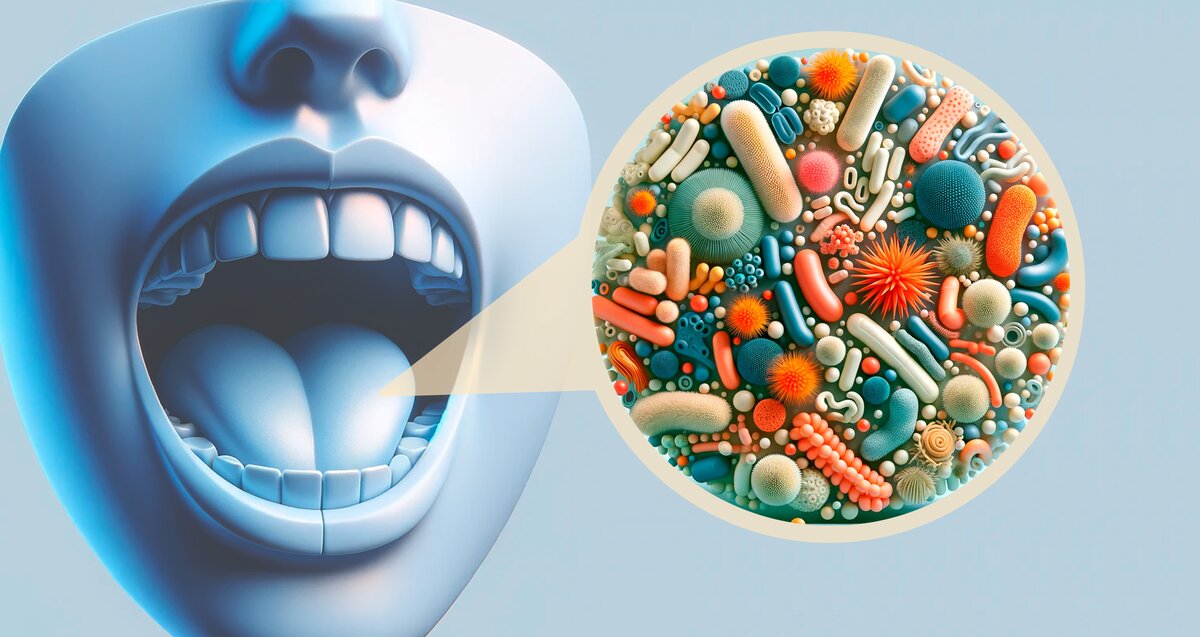Science
Gums and Tums - what is the connection?
08 February 2024

The relationship between the oral and gut microbiomes has become the subject of an increasing amount of research. The mouth is host to the body’s second most complex microbiome, after the colon, and there is evidence of associations between periodontitis and inflammatory bowel diseases. But the key debate is less about causality and more about the links between the respective immune-inflammatory responses and associated microbiomes exacerbating established disease. Professor Iain Chapple, former secretary general of the EFP, guides us through the terrain and highlights the key questions that remain to be answered.
Non-communicable diseases (NCDs) are the major cause of disability and mortality globally, responsible for 71% (40 million) of deaths, 16 million of these being premature (PMID: 27061677). Periodontitis is a ubiquitous and highly prevalent NCD that has been investigated for its relationship with at least 57 systemic NCDs, including inflammatory bowel disease (IBD), colorectal cancer (CRC), type-2 diabetes (T2D), rheumatoid arthritis (RA), chronic kidney disease (CKD), and atheromatous cardiovascular disease (ACVD) (PMID: 26881700).
Severe periodontitis has increased in prevalence by 8.44% in the last 30 years and now affects 18.9% of the global adult population (PMID: 34101223; WHO 2022), accounting for 3.52 million disability-associated life years. IBD – principally ulcerative colitis (UC) and Crohn’s disease (CD) – is a global epidemic (PMID: 29050646), impacting 1.3 million people in Europe, and approximately 0.3% of the populations of North America and Australia. While levels have largely stabilised in industrialised countries, there is an increasing prevalence in emerging industrialised economies in Asia, Africa, and South America (PMID: 29050646).
Ulcerative colitis was first reported in 1875 (Wilks and Moxon) and what later became known as Crohn’s disease in 1932 (Nuboer FJ, 1932). Oral manifestations were first reported in 1957 in the form of aphthous ulceration (Sircus et al 1957) and 1969 in the form of granulomatous gingival and oral mucosal inflammation (Dudeney & Todd). “Pseudo pockets” were identified in 1972, caused by the associated gingival inflammatory overgrowth in IBD (Bottomly et al 1972).
However, such oral and gingival manifestations of inflammatory bowel diseases are distinct from causal-association studies between IBDs and periodontitis itself, where positive associations have been reported in several investigations.
A recent meta-analysis revealed significantly increased risk for periodontitis in Crohn’s disease (OR 3.64; 95% CI: 2.33-5.67) and ulcerative colitis (OR 5.37; 95% CI: 3.3-8.74) with an overall elevated risk in IBDs of 3.17 (95% CI: 2.09-4.8) (She et al 2020). A key confounder of the periodontitis-IBD association is age, with IBD patients generally being younger than periodontitis patients at disease inception and subsequent diagnosis. The key debate in relation to periodontitis and IBDs is less about causality and more about the links between the respective immune-inflammatory responses and associated microbiomes exacerbating established disease.
Microbiomes & microbiota in IBD and Crohn’s disease
The Human Microbiome Project (HMP) developed between 2003 and 2009 and started to sequence the microbiome of key human sites, principally the gut, the oral cavity, skin, lungs, and the genitourinary tract. In 2007, the first 500 sequenced bacterial genomes (16s ribosomal RNA sequencing) revealed a percentage distribution by body site of:
- Gastrointestinal (GI) tract – 29%
- Oral cavity – 26%
- Skin – 21%
- Airway – 14%
- Urogenital tract – 9%
However, 16s ribosomal RNA identifies only the highly conserved regions of bacterial ribosomal RNA and is therefore limited in its approach to “microbiome” sequencing – for example, it will not identify viruses. More recently, metagenomic approaches that identify all genetic material from prokaryotic cells (bacteria and archaea), viruses, and protozoa – i.e., our “microbiota” – have advanced the field considerably. Terminology is of course key to understanding this complex field:
- Our “microbiome” is the combined genetic material of all microorganisms in a particular environment (bacteria, viruses, fungi, protozoa, archaea) – that is, a collection of microbial genomes.
- Our “microbiota” refers to the living microorganisms that inhabit a specific body niche.
These two terms are frequently confused and used interchangeably.
The human body contains between 75-200 trillion microorganisms compared with50-100 trillion human cells, and with 10,000 different species identified in the HMP, comprise 1-3% of our body mass. We are therefore “holobionts” (superorganisms) that, by and large, live in harmony with our bugs, in co-called “symbiosis”. The ratio of microbial cells to human cells is thus approximately 2:1 and not 10:1 as previously thought. In general, the more diverse the composition of the microbiome, the healthier the relationship with the hosts’ immune-inflammatory system. Reductions in microbial diversity tend to reflect a dominance of particular pathogenic organisms.
Dysbiosis within the Oral and Gut microbiomes
The emergence of specific pathogens that start to dominate an ecological niche is called “dysbiosis” and the relationship between dysbiosis and inflammation is a complex one. Nevertheless, periodontal dysbiosis is associated with multiple inflammatory non-communicable diseases (NCD) including inflammatory bowel diseases (IBD), principally ulcerative colitis and Crohn’s disease. The mouth is host to the body’s second most complex microbiome, after the colon. Many NCDs, including periodontitis and IBDs, are driven by dysregulated immune-inflammatory responses to microbiota imbalance. Moreover, periodontitis and IBD are reported to impact each other’s progression through a bidirectional relationship wherein both oral inflammation and oral microbiota dysbiosis impact the gut microbiota inducing inflammatory changes (PMID: 33679761), and vice versa (PMID: 32758418).
The microbiota of the mouth and the small and large intestine represent distinct microhabitats with specific microflora, which also vary along the course of each organ. However, genomic studies from across the globe have demonstrated enrichment of oral species within the GI tracts of IBD patients, specifically Fusobacterium nucleatum (F. nuc), Campylobacter concisus (C.c), Eikonella corrodens (E.c), Veillonella parvula (V.p), Heamophilus parainfluenzae (H.p), Prevotella spp, Streptococcus spp, Aggregatibacter spp, and Corynebacterium spp, using gut biopsies as well as stool samples (reviewed by Read et al 2021).
These studies are genomic studies and analyse the microbiome rather than our “microbiota”, and the viability and growth of those bacteria cannot therefore be ascertained. Viable F. nuc and C.c have, however, been cultured from gut biopsies and therefore appear to demonstrate an oral-gastrointestinal route of transmission. In addition, viable S. salivarius, V. Parvula, F. nuc, and C. c have been isolated from healthy GI tracts. Colonisation of the GI-tract by oral bacteria is limited in the healthy gut, but enrichment with oral bacteria is reported in IBD. Oral bacteria have been calculated to comprise approximately 2% of faecal bacterial species.
How these oral bacteria reach the intestines is less clear, with potential routes involving the swallowing of saliva, haematogenous spread from the ulcerated periodontal pocket lining or sulcular epithelium, spread via the lymphatics, and even the “Trojan horse model” whereby certain oral pathogens such as P. gingivalis and F. nuc have been shown in mice to remain viable inside host immune cells, which may then traffic to the intestinal vasculature. However, human studies of viable oral bacteria within the GI-tract remain limited.
Periodontitis was first linked to IBD in a classical study by Van Dyke and colleagues (1986), who characterised the microbiota of periodontal pockets in IBD patients with co-morbid periodontitis and in IBD volunteers without periodontitis but with oral manifestations of IBD. They demonstrated distinct differences in the microbiota between these two groups. There are also distinct differences between the salivary and plaque microbiomes of IBD patients, with elevated diversity and enrichment in saliva from ulcerative colitis patients with Streptococcus spp and Enterobecteria and in Crohn’s disease of Veillonella relative to healthy controls (Xun et al 2018).
Overall, untreated Crohn’s disease appears to be characterised microbially by Bacteroides, Campylobacter, Fusobacterium, Veillonella, Porphyromonas,and Prevotella species, and severe ulcerative colitis by Veillonella dispar, Veillonella parvula, Heamophilus parainfluenzae, and Campylobater spp (Schirmer et al 2018). Importantly, Fusobacteria spp, Prevotella spp, Streptococcus spp, and Veillonella spp were found in ulcerative colitis gut biopsies rather than stool samples, raising the potential for these oral bacteria to colonise inflamed mucosa, consistent with current concepts in periodontitis whereby oral dysbiosis appears to arise as a consequence of periodontal inflammation (PMID: 32296429).
The role of the inflammatory-immune system in the Gum-Gut axis
The concept of a “gum-gut” axis was recently proposed by Byrd and Gulati (2021), and Read et al (2021) recently critically summarised the evidence to date for common pathophysiological pathways for periodontitis and IBDs, consistent with a gum-gut axis. These include:
- the development of dysbiosis in response to mucosal inflammation orchestrated by cytokines (IL-1β, TNFα, IL-6), reactive oxygen species (ROS), and nitric oxide responses.
- a dysfunctional immune-inflammatory response to the emergent dysbiosis, which further drives mucosal and submucosal inflammation, tissue damage, and associated complications.
- a permeable/leaky epithelial barrier which ultimately breaks down and ulcerates, facilitating microbial entry into underlying connective tissues.
- adaptive immune responses characterised by TH-1 and TH-17 lymphocytes and associated cytokines.
- A submucosal influx of macrophages and dysfunctional neutrophils, where chemotaxis is impaired and ROS release is exaggerated.
- A “hyperinflammatory” response of various immune cells that, under the influence of a dysbiotic microbiota, induce a dysregulated immune-inflammatory response that propagates rather than resolves the infectious-inflammatory condition.
In a key “mouse model” study, Kitamoto et al (2020) demonstrated that TH-17 cells that are produced by – and likely also primed in response to – oral bacteria such as Klebsiella pneumoniae transit to the microcirculation of the colon and, when they encounter such oral bacteria for a second time, initiate a TH-17- and TH-1-cell-driven colitis. Similar events have been demonstrated with F. nucleatum, a gut tropic oral pathobiont that triggers CD4+ T cell differentiation into TH-17 and TH-1 cells to mount an immune-inflammatory response. To date, this has not been demonstrated in humans, but it offers a very plausible mechanistic explanation that links the oral microbiota with IBDs, irrespective of the severity of the periodontal condition.
Periodontitis and IBDs are complex diseases, where multiple risk factors and pathways converge to trigger manifest disease. The similarities in the pathophysiology of these diseases are perhaps not unexpected, given that they arise at a mucosal surface that is colonised by a complex microbiota and that permits bidirectional communication between microbes and the immune-inflammatory response, which under certain conditions may result in mucosal ulceration. The immune responses in both IBD and periodontitis are characterised by neutrophilic and myeloid cell activity, and by TH-1 and TH-17 cell responses, whose cytokine release (IFNƳ, IL-17) further triggers myelopoiesis and the recruitment of neutrophils and other myeloid cells, resulting in the release of TNFα, IL-1β, IL-6, ROS, and nitric oxide. Initial inflammation appears to drive dysbiosis via iron and protein availability and the resulting dysbiosis further drives the destructive inflammatory-immune sequelae, in a circular manner.
Future directions
Tailoring therapies to individual patients using molecular profiling linked to detailed endoscopy profiles of inflamed mucosa is a major unmet need in IBD (PMID: 28322774; PMID: 32201877) . Whereas accessing diagnostic biological samples for gastrointestinal diseases requires invasive, risky, and costly endoscopy, saliva is a readily accessible diagnostic fluid rich in biological fingerprints of both oral and systemic conditions.
Key questions therefore that remain to be answered are:
- Can saliva reveal early diagnostic signatures of IBDs, enabling earlier diagnosis and thus improving outcomes of precision IBD therapies?
- Can salivary signatures predict outcomes of precision IBD therapies?
- Can manipulation of the gut microbiota reduce systemic and oral inflammation, and thus help transition oral dysbiosis to symbiosis?
- Can oral microbiota manipulation improve the composition of the gut microbiota and reduce gastrointestinal and systemic inflammation, supporting the restoration of gastrointestinal symbiosis?
The future of microbiota manipulation as a novel strategy to improve both gastrointestinal and oral mucosal health is an exciting one, and we are at the end of the beginning of research into this complex relationship. There is a need to unite the disciplines of microbiology and immunology, periodontology, and gastroenterology to make breakthroughs in the management of IBDs and periodontitis, based upon their intimate relationships.
In conclusion, there are multiple similarities between periodontitis and IBD with respect to their pathophysiologies. In addition, the mouth and the gut form part of the same mucosal tract but provide numerous microhabitats to host specific consortia of bacteria. Both are subject to epithelial ulceration in response to underlying inflammatory-immune responses to emergent dysbiosis within their microbiota. Oral microbes are limited in their colonisation of the GI-tract in gastrointestinal health, but increase in prevalence in IBD, and may contribute to the progression or severity of established IBD via interactions with the immune response. Therefore, there is potential for microbiome manipulation as a therapeutic strategy for periodontitis and IBD, provided the health promoting consortia of microorganisms restore the symbiotic relationship with the host response.

Biography
Professor Iain Chapple is an active member of the EFP. He was the federation's treasurer (2007-2013), chair of the scientific affairs committee and editor of JCP Digest (2013-2016), and secretary-general (2016-2019), as well as a co-organiser of Perio Workshop and an associate editor of the Journal of Clinical Periodontology. A current associate editor of Periodontology 2000, he was previously scientific editor of the British Dental Journal and associate editor of the Journal of Periodontal Research. He has written 14 textbooks and 40 book chapters, and has published over 250 peer-reviewed manuscripts in international scientific journal. He is a former president of the British Society of Periodontology (2014-2015).
Until his retirement in July 2023, Iain was professor of periodontology, consultant in restorative dentistry, and head of research at the Institute of Clinical Sciences, University of Birmingham, UK. He was awarded the Charles Tomes medal of The Royal College of Surgeons (2011), IADR Distinguished Scientist in Periodontal Research (2018), AAP Special Citation Award (2018), and the EFP’s Eminence in Periodontology Award (2022). In 2022, he was appointed an MBE (Member of the Most Excellent Order of the British Empire) in the Queen’s New Year Honours list 2022 for services to oral and dental health.





